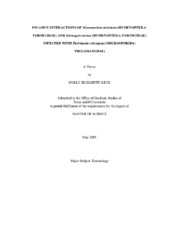Invasive interactions of Monomorium minimum (Hymenoptera: Formicidae) and Solenopsis invicta (Hymenoptera: Formicidae) infected with Thelohania solenopsae (Microsporida: Thelohaniidae)
Abstract
Thelohania solenopsae Knell, Alan, and Hazard is an internal microsporidian
that parasitizes the red imported fire ant, Solenopsis invicta Buren. This experiment
studied the invasive interactions between the native United States ant, Monomorium
minimum (Buckley), and S. invicta colonies infected with T. solenopsae and S. invicta
colonies free of parasites. This study utilized S. invicta colonies of 100, 300, 600, 800,
and 1000 workers to determine the ability of 1000 M. minimum workers to invade each
S. invicta colony size. There was a significant difference in the time for M. minimum to
invade S. invicta when comparing S. invicta colonies of 1000 workers infected with T.
solenopsae to S. invicta colonies that were uninfected. It was also determined that there
was a significant difference in the time for M. minimum to invade smaller uninfected S.
invicta colonies as opposed to larger uninfected S. invicta colonies. There was no
significant difference in the ability of M. minimum to invade smaller S. invicta colonies
infected with T. solenopsae as opposed to larger infected S. invicta colonies. It was
therefore concluded that S. invicta colonies infected with T. solenopsae were not able to
defend their colony or prevent competing ants from invading as well as uninfected S.
invicta colonies. This study also demonstrated that M. minimum is a significantly more
invasive species when compared to S. invicta, invading S. invicta territories in every
situation and doing so in a significantly shorter period of time than S. invicta colonies
invaded M. minimum colonies.
Citation
Keck, Molly Elizabeth (2003). Invasive interactions of Monomorium minimum (Hymenoptera: Formicidae) and Solenopsis invicta (Hymenoptera: Formicidae) infected with Thelohania solenopsae (Microsporida: Thelohaniidae). Master's thesis, Texas A&M University. Texas A&M University. Available electronically from https : / /hdl .handle .net /1969 .1 /3986.


